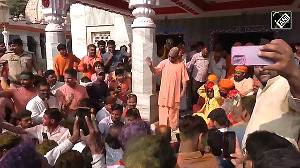This is how Nehru, the builder of modern India addressed the nation on the eve of Independence in 1947. Six decades later it is good to look back and see whether these dreams have been on the right track.
One cannot help remembering these prophetic words when Chandrayaan I took off on October 22. It is a tribute to Nehru on his birth anniversary today that we pay homage to this great Indian.
After centuries of invasions and internal turmoil, the last occupation of undivided India was by the British. It lasted for nearly a century before the non violent struggle of Gandhi brought it to an end, though with great pain of the partition of the country.
However the British left a legacy in terms of a well connected railway system, the English language in a country of 17 different languages and encouraged the study of science, however limited it was.
It is notable that the country's only Nobel Prize winner in Science (Physics) was C V Raman in 1930 for his work in light scattering which forms the basis of lasers; and Rabindranath Tagore in Literature in 1913 -- both in pre-independent India.
In post independent India, Amartya Sen was awarded for Economics in 1998.
Jawaharlal Nehru trained in Oxford but was influenced by the then Soviet model of industrial development. He was an active participant in the freedom struggle. Prior to achieving Independence, he already had formed a vision for the country's development and passionately believed that science was the only way to eliminate poverty in India.
Thus soon after the now famous 'Tryst with Destiny' speech in 1947, he embarked on an economic policy which many economists now believe laid the firm foundation for liberalisation in the 1990s.
It was socialistic in name but left enough space for the private sector. The commanding heights of the economy like the railways, steel and heavy machine building industry, and the power industry were all in the public sector with meaningful technical collaborations with the West and also the then Soviet Union.
The conditions of collaboration were that there must be a transfer of technology and not just turn key operations as were implemented in some other developing countries. The latter model would have left the country in a big mess since the country did not have the requisite science and technology manpower at that time.
It is important to keep this in mind as we conduct our science and technology ventures after the nuclear deal.
The planned investments in science and technology that the country made through the establishment of a chain of research laboratories as well as the starting of IITs with foreign help including the US took nearly two, three decades to have some effect in generating scientific and technical manpower of a critical size.
Thus, when IBM and Coca-Cola had to leave the country in the late 1970s, the Indian management and technical skill set quickly filled the gap. The country adopted a pro- business approach to development in 1980 under Indira Gandhi and then Rajiv Gandhi.
This is an essential prerequisite for any country to prosper as an economic power. Visionaries like Homi Bhabha and his successors helped shape the atomic energy programme and laid the seeds of the electronic revolution. Vikram Sarabhai laid the foundation of the space industry.
In education, the influence of President John F Kennedy and Ambassador John Kenneth Galbraith left a lasting legacy in terms of unleashing the computer revolution in India through the then advanced IBM 1620 at IIT Kanpur in 1963.
The IT manpower generated through this had a large multiplier effect which is now there for all to see.
Much as she is criticised for other things, Indira Gandhi in the late 1960s and 1970s left her own imprint on modern India. The nationalisation of banks and the insurance sector resulted in making those services available in rural India.
In the context of the current global crisis and the choices before the US, one can see the wisdom of a Nehru who chose the middle path in 1947. The fruits of the Green, Milk and Telecom revolution are there for all to see.
If properly harnessed, the fruits of both the Internet and space revolution can change the rural landscape. These activities would not have happened if the country had embarked on liberalisation in the first four decades after Independence. Computerisation in all sectors of the economy had fierce opposition from the labour unions and being a democracy it took time for it to be accepted by all.
The 21st century saw the maturing of India in terms of developing world class managerial skill set through the schools of management which paved the way for a smooth transition to globalisation.
A sustained 7 to 9 per cent growth was now possible and for many, a college education with exposure to IT is now a passport for a good job. This has never happened in India since 1947.
India now has a great demographic advantage in having half the population in the 25+ age bracket. The so-called brain drain of the 1960s and 1970s is now reversing. The economic fundamentals that were laid out in the first four decades which many dub as the period of 'Hindu' rate of growth paid off ultimately and the country is now well poised to being an economic power in its own right.
Hence, it is easy to understand why there is a 300 million strong middle class with disposable income. The almost exponential growth in cell phones and mobile technology is set to change the face of rural India. IT is now poised for the next phase of growth in terms of innovation, thus climbing the value chain. The country needs to move beyond IT in the realm of mathematics and computer science and nurture future Ramanujans.
In some sense India offers a text book case of development for a poor country. India had the good fortune of a secular and democratic Constitution similar to the US and with those attributes progress at times, seems slow. In the long run it is worth the effort. Gender equality as well as inclusiveness of low income people is aggressively pursued.
There are, however, many sectors particularly the infrastructure like water, health, electricity, roads and education which are in a sorry state of affairs.
These are the areas where the country needs committed leadership and vision to implement. The private sector must be involved in a major way. For example in the power sector it is time to examine whether the state electricity boards in spite of the reforms are doing an adequate job.
It is time to privatise the government-managed power sector. Institutions like the Bharat Heavy Electricals etc have proved equal to the task. For a country which is one third the size of US and has 1 billion people, there is no place to grow except vertically for which we need reliable electric power to operate elevators, pumps etc.
Renewable technologies have a place, but not to the exclusion of grid power with efficient power plants with a minimum of theft and electrical losses. The nuclear deal is not a solution for the next 10 to 15 years.
The state of education is in disarray. At the primary level privately managed schools with a secular outlook must be encouraged and perhaps supported by the government. At the higher education level the quota crisis has distorted the picture greatly. The poorer sections of the society are still left out.
The whole range of infrastructure issues needs attention by competent people as in the days after Independence. There in lies the challenge of today and tomorrow.
M A Pai is Professor Emeritus, Department of Electrical and Computer Engineering, University of Illinois at Urbana-Champaign.






 © 2025
© 2025